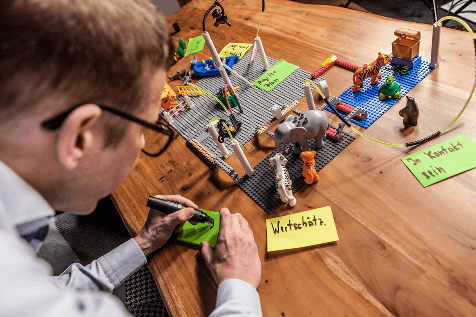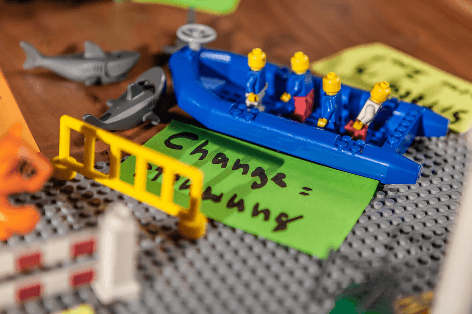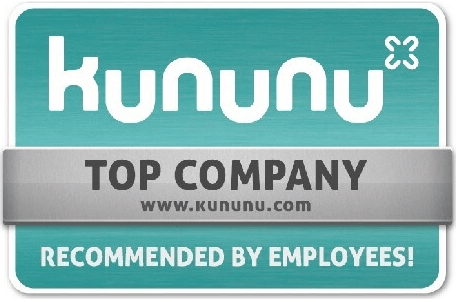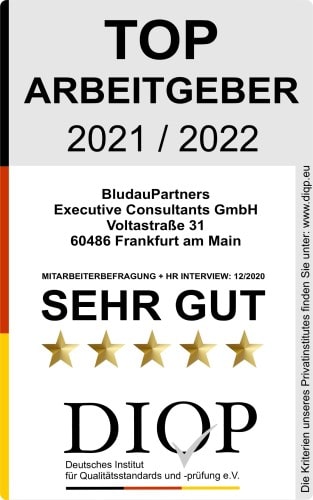HOW TO PLAYFULLY LEAD A COMPANY TO SUCCESS
In a survey of approximately 1,500 executives worldwide conducted by IBM in 2010, 69% of those surveyed said that, in their view, the world is becoming more dynamic and risky. In addition, 60% and 65% of the participants in the study respectively believe that uncertainty will increase and complexity will grow.
Surprisingly, the business leaders surveyed stated that they are not sufficiently prepared for these challenges:
THE INITIAL SITUATION
While 79% of managers expect a high to very high level of complexity within the next five years, less than half (49%) actually feel up to these changes and developments.[1] These findings are underpinned by a current study on the topic of "agility" by the management consultancy Kienbaum.[2] The study showed that a large proportion of companies operate in an environment that requires agile behavior. However, the study also reveals that the agility of the companies is not as strongly developed or pronounced as it should be from the perspective of the people surveyed.

It is also a fact that less than two-thirds of the change targets are achieved on average in companies. Mistakes in the design of the change process lead to those affected being demotivated, productivity suffers and employees leave the company in the worst case scenario.
One in two of them is sceptical about change.
THE DIALOGUE AS A CORE PROCESS OF SUSTAINABLE CHANGE

In today's world, the ability to change and thus also to innovate is becoming a decisive competitive factor. On the one hand, they create an important differentiation in markets and business models, and on the other hand, they ultimately ensure the viability of the entire company.
If the key skills of leaders are to effect change, ensure continuous organisational learning and enable communication so that the organisation as a whole operates successfully, this is an indication that leadership skills that focus on building relationships and thus dialogue are coming to the fore. Baldwin[3] defines such a dialog-oriented conversational leadership approach as "the active use of conversations as a core process to create the team intelligence necessary to build economic and social value."[4]
New forms of joint thinking are indispensable, especially when dealing with complex issues, such as those frequently arising in connection with the design of change and innovation processes - and if positive development and change are to be experienced and encouraged.
HOW CHANGE CAN BE MADE
If managers succeed in implementing and using such discussions as a central core process - which brings about positive development and change - not only does an increase in intellectual and social capital in the organisation take place, but a competitive advantage is also created in an increasingly networked world.
There are people in companies who claim that only where encounters take place and relationships are formed, further developments and changes can be successful and people can shape the future with commitment and enthusiasm. When managers plan, conduct and follow up such discussions on relevant and "burning" topics, they gain access to previously undreamt-of opportunities and potential. Our present "world" is currently often referred to as the "VUCA world": The word "VUCA" is composed of the initial letters of the terms "Volatile", "Uncertain", "Complex" and "Ambiguous". The knowledge necessary to deal with such situations can be found in the minds of employees - as social, implicit and experiential knowledge.

However, this special knowledge not only relates to content-related issues, but also to dealing with change and the new. As a consequence, modern change and innovation methods are always collaborative processes at their core. These processes always involve people with different perspectives, backgrounds, experiences, specialist knowledge and ideas, who work together to find a solution.
This in turn creates new knowledge, new ideas and ultimately change or innovation. Various factors are critical to the successful design of such a change process:
A COLLABORATIVE APPROACH

On the one hand, an attractive picture of the future, including a suitable strategy, is needed to achieve this, and on the other hand, it is also important to keep an eye on the "origin" (such as willingness to change, structures, etc.). Within the framework of such a development project, the respective culture (e.g. experiences, competencies in dealing with change, how is leadership experienced in times of change, how is cooperation within and between different teams etc.) must always be considered, because "culture eats strategy for breakfast". [5] In my practical work with companies, the use of Lego bricks in workshops has proven itself. This helps employees and managers to make solutions for their specific questions tangible. By playing through scenarios, the effects of the solution variants can be simulated simultaneously. "Social learning cannot be read off a PowerPoint slide," explains Axel Rachow. [6] "On the other hand, he who plays through situations himself - lives his role and the dynamics of the group very closely."
The rules of the game are simple: each workshop participant builds, each explains their model, each listens and each has exactly one vote. At the end of this creative process, a joint model is then built. This approach is particularly suitable for the joint development of future/target images, change strategies, discussions of team values and dialogue and feedback cultures.











